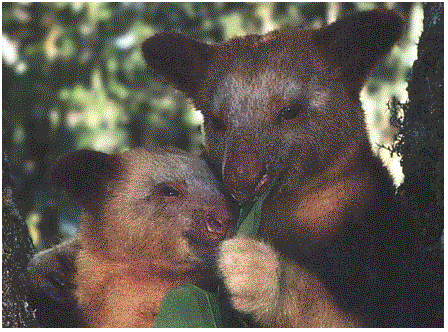By: Reed
HABITAT
A Golden Lion Tamarin's habitat is in South American the dense part of the rain forest or swamp forest in the canopy on the large branches. A GLT's home is a thing called a tree hole. A tree hole is one of the holes in a rain forest tree. Scientists and researchers think that GLTs live in these tree holes for warmth and protection from predators.
PREDATORS
A GLT's predators are: hawks and other vicious birds, snakes, and large cats. When a predator comes a GLT will make a distinct call that lets other GLTs know there is a predator near by. When a predator is actually in their territory, GLTs will run down the tree and hide by its trunk or some will, unfortunately, plummet to their death!
DIET
A GLT is an omnivore meaning that they eat meat and plants. Its diet includes: flowers, fruit, nectar, tree saps and gums, insects, spiders, lizards, amphibians, and snails. Now at a zoo ( which is where, unfortunately, most of them live) it would basically be the same diet except that the lizards and amphibians would be frozen and dead. At the zoo they also make a special mix of vitamins to help the GLT become stronger and healthier.
LIVING HABITAT
GLTs live in groups of 2-9 members. These groups include one married couple and seven other babies. Now your probably thinking how does another GLT act with another GLT? Well when one GLT trespasses in another GLT's territory, then the two GLTs will not physically fight but will vocalize with each other. Just like there is a distinct call for predators there are distinct calls for fighting.
IS THIS MAMMAL ENDANGERED?
YES, YES, YES, AND AGAIN YES!!!!!! The GLT is very much endangered. Only 2% of their forests are still remaining. The GLT doesn't really have one forest to live in, all of their forests were cut down so much that what they do have to live in is a bunch of little forests close by each other. A GLT is not only endangered because of the deforestation but they are also endangered by how little of them there are left. Only about 900 or so are alive today. And 500 of those 900 live in zoos. A lot of those 500 live in a zoo in Rio de Janerio called Reserva Biologica de Poco Das Antas.
FUN FACTS!!!!!!
A GLT's territory covers up to 100 acres. GLTs use something called micro manipulation. This is where a GLT sticks its small slender hands into a tiny place to get its food.
Sloths
by Tierra
The sloth lives in South America, Central America, especially Brazil, in the tropical rainforests. It moves very slowly. It takes a sloth about a week to get up into a tree. When they climb trees, they hang upside down. When they hang, they hold onto the branches with their claws. Their sharp claws help them stay up in the trees. They fall asleep hanging from the trees.
Sloths eat twigs, leaves, and buds. They only need a little food because they have a low metabolism rate. The sloths turn food into energy. The greenish color of the sloth's fur is really from algae that live on the animal. This animal is not in a hurry to get places!
Clouded Leopard
by Stephanie
The clouded leopard has a long body, a big tail, fairly short legs, and big paws. They have long "eye teeth" for ripping apart meat, and they have been compared to the Saber- tooth Tiger. Their snout is big, the head is thin, and the pupils are yellow. The adult male clouded leopard is about 6 feet long, and weighs between 35-50 pounds, but the females are smaller. Clouded leopards usually can be found deep in a forest away from humans. A clouded leopard's food sources are: monkeys, small deer, and wild boars. They may also eat birds or rodents. Clouded leopard can climb trees very well, and use their long heavy tails to balance on branches. They sleep in the day time and hunt there pray at night. A female clouded leopard can be pregnant for 90 days, and have 2-4 cubs, which are born in a hollow tree. The cubs eyes open after 10-12 days, and are active after 5 weeks.

Tree Kangaroo mother and baby